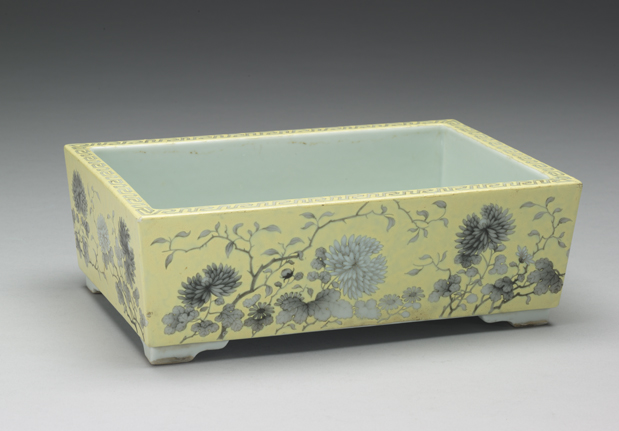Rectangular planter with chrysanthemum pattern in fencai painted enamels and “Tihedian zhi” mark, Qing dynasty, Guangxu reign (1871-1908)
- Image Number: K1B000208N000000000PAB
- Dynasty: Qing dynasty
- Category: Ceramics
- Function: Floral apparatus
- Material: Mineral/ceramic/porcelain
- Description:
Rectangular flowerpot, straight mouth wall, trapezoidal foot. White glaze is applied inside the utensil, and the outer wall is surrounded by a cluster of ink chrysanthemums painted in yellow, which is unfolded on all sides to form a cluster of chrysanthemums. The blossoming flowers use the traditional literati’s brush and ink techniques of spotting and texturing, and use the glass white halo to dye into different colors, such as gray and white, with dense shades. The matrix is thick, and there are 16 small round support nails at the bottom of the device in two circles, which are the support to prevent the collapse and deformation of the bottom during vertical burning. The seal character of “Ti He Dian Zhi” in the bottom ink script. The chrysanthemum decoration has the meaning of “longevity”, which also highlights the implication of Cixi’s longevity. The Hall of Body Harmony is the hall in the Palace of Storage and Exquisition, the residence of Empress Dowager Cixi. It is a space for dining, tea drinking and daytime rest. According to the Records of the Office of the Ministry of Internal Affairs of the Qing Dynasty, the prototype of the “Tihe Hall” porcelain was painted by the painting academy in December of the 11th year (1885) of the reign of Emperor Guangxu of the Qing Dynasty, and was completed in February of the next year (1886)

Pictures & Images [HD] download
© Copyright
The copyright of the article belongs to the author, please keep the original link for reprinting.
THE END





![[Qing Dynasty] British female painter—Elizabeth Keith, using woodblock prints to record China from the late Qing Dynasty to the early Republic of China—1915-China Archive](https://chinaarchive.net/wp-content/uploads/2022/11/image-191x300.png)